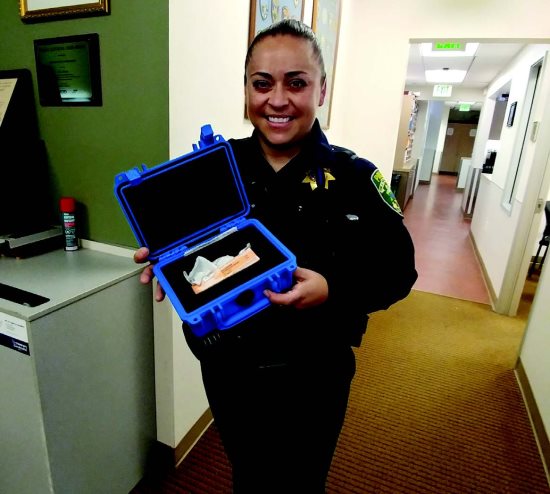 | | | Officer Fabiola Hernandez displays the lifesaving kit used by the Moraga PD. Photo Nick Marnell | | | | | | Moraga Chief of Police Jon King announced at the Aug. 22 town council meeting that his officers have been approved by the emergency medical services director of Contra Costa Health Services to carry and administer Naloxone, medication used to reverse the effects of an opioid overdose.
 According to CCHS, opioid-related deaths rose from 42 in 2013 to 53 in 2016. "That translates into one death per week in Contra Costa County in 2016 due to opiate overdose," said CCHS Director Anna Roth in a statement. "Death related to opiate use is all the more tragic because it is preventable."
According to CCHS, opioid-related deaths rose from 42 in 2013 to 53 in 2016. "That translates into one death per week in Contra Costa County in 2016 due to opiate overdose," said CCHS Director Anna Roth in a statement. "Death related to opiate use is all the more tragic because it is preventable."
 Properly administered, Naloxone can prevent an opioid-related death. Moraga police officers have been trained on the procedure, the amount to administer and the potential side effects, including victims who may vomit upon resuscitation. King said that three officers in the field will carry Naloxone kits, with one kit remaining in the police station.
Properly administered, Naloxone can prevent an opioid-related death. Moraga police officers have been trained on the procedure, the amount to administer and the potential side effects, including victims who may vomit upon resuscitation. King said that three officers in the field will carry Naloxone kits, with one kit remaining in the police station.
 Firefighter-paramedics of the Moraga-Orinda Fire District and the Contra Costa County Fire Protection District also carry Naloxone, but police cars are more likely to arrive to an emergency scene before a fire engine, and administering the drug to a patient in those early minutes or seconds can be the difference between life and death.
Firefighter-paramedics of the Moraga-Orinda Fire District and the Contra Costa County Fire Protection District also carry Naloxone, but police cars are more likely to arrive to an emergency scene before a fire engine, and administering the drug to a patient in those early minutes or seconds can be the difference between life and death.
 "If we're wrong, we won't hurt anybody," King said of administering Naloxone to a patient with overdose symptoms who did not need the drug.
"If we're wrong, we won't hurt anybody," King said of administering Naloxone to a patient with overdose symptoms who did not need the drug.
 CCHS requires that all officers receive refresher training on the use of Naloxone, the police department must report every use of the drug to the county EMS agency and the department must also submit an annual deployment report to the agency.
CCHS requires that all officers receive refresher training on the use of Naloxone, the police department must report every use of the drug to the county EMS agency and the department must also submit an annual deployment report to the agency.
 In 2017, the Lafayette Police Department became the first in Contra Costa County to authorize its officers to administer Naloxone. According to Police Chief Mark Nagel, Orinda police will receive training in the use of the drug once the Sheriff's Office schedules the classes.
In 2017, the Lafayette Police Department became the first in Contra Costa County to authorize its officers to administer Naloxone. According to Police Chief Mark Nagel, Orinda police will receive training in the use of the drug once the Sheriff's Office schedules the classes.


|
